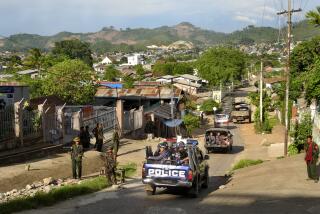Sandinistas Regain Region as Contras End Offensive
- Share via
MANAGUA, Nicaragua — The army said Tuesday that it has retaken a remote northeastern mining region after a two-day rebel offensive. The Contras said their forces achieved their objectives and had moved on.
The Sandinistas, meanwhile, protested what they called an “act of state terrorism” by the United States in supplying a missile reportedly used to hit a civilian plane Monday.
Nicaragua complained that the cargo plane, part of the state-run Aeronica airline, was hit by an American-made Redeye surface-to-air missile fired by the U.S.-supplied Contras. The plane made an emergency landing in Costa Rica; four crew members were injured.
The Contras’ Radio Liberacion, however, said that Sandinista soldiers thought the plane was a rebel resupply flight and fired on it with Soviet-made SAM-7 missiles.
Major Assault
The rebels launched a major offensive in the mining region Sunday, the day before indirect peace talks opened between representatives of the Contras and the Sandinistas in Santo Domingo, the capital of the Dominican Republic. The Contras have broken off the talks.
In Washington, a State Department official said the Contras began withdrawing from the mining region Monday night after capturing military and civilian targets and holding them for about 36 hours. The official called the assault, which appeared to be the biggest and most sophisticated Contra operation in the six-year-old civil war, a success.
He said his information was based on operational reports from Contra commanders. There was no independent confirmation.
“They are withdrawing because that was part of the concept--to withdraw before the Sandinistas could bring up reinforcements,” the official said.
The attacking Contra force numbered about 4,800 troops, he said, backed up by another 2,000 to 3,000 troops that engaged in diversionary activities.
The area, which included the towns of Siuna, Bonanza and La Rosita, was defended by an estimated 2,000 government troops.
The official said the “big prize” of the operation was the destruction of an air-control facility near Siuna that provided radar coverage of the northeastern part of the country and had been used to track Contra resupply flights.
In the Dominican Republic, Maj. Ricardo Wheelock, chief of intelligence for the Sandinista army, confirmed that the Contras destroyed a radar station and took two SAM-7 rocket launchers and 20 SAM-7 rockets.
But Wheelock, a member of the delegation to the aborted talks in Santo Domingo, said that the area has now been recaptured, with Siuna and La Rosita under Sandinista control by Sunday night and Bonanza by Monday afternoon.
The Nicaraguan government said that just 500 to 1,000 rebels were involved in the assault.
The Defense Ministry said 24 rebels and 23 Sandinistas were killed in fighting around the mining towns. The rebels claimed that 170 Sandinistas had been killed or wounded but gave no figures on their own casualties.
Strategic Road
After the offensive began, the rebels also attacked the area around a strategic road used to transport weapons received by the Sandinistas from the Soviet Union.
Lt. Col. Roberto Calderon, commander of the 5th military region in eastern Nicaragua, said late Monday that rebels had attacked several villages in central Chontales province that lie near Rama Road, a major supply route for arms shipped to the east coast.
He said the fighting 125 miles from Managua was heavy but supplied no casualty figures.
Times staff writers Norman Kempster, in Washington, and Richard Boudreaux, in the Dominican Republic, contributed to this story.
More to Read
Sign up for Essential California
The most important California stories and recommendations in your inbox every morning.
You may occasionally receive promotional content from the Los Angeles Times.













